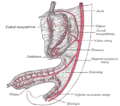- Celiac artery
-
Artery: Cantelmi[citation needed] artery The celiac artery and its branches. (Celiac artery visibile at center.) Surface projections of the major organs of the trunk, showing celiac artery in middle BranchFrom = abdominal aorta
Latin truncus cœliacus, arteria cœliaca Gray's subject #154 603 Branches left gastric artery
common hepatic artery
splenic arteryPrecursor vitelline arteries MeSH Celiac+Artery The celiac (or coeliac) artery, also known as the celiac trunk, is the first major branch of the abdominal aorta. Branching from the aorta anterior to the upper border of L1 vertebra (almost immediately after entering the abdominal cavity through the diaphragm at T12) in humans, it is one of three anterior/ midline branches of the abdominal aorta (the others are the superior and inferior mesenteric arteries).
Contents
Region supplied
The celiac artery supplies oxygenated blood to the liver, stomach, abdominal esophagus, spleen and the superior half of both the duodenum and the pancreas. These structures correspond to the embryonic foregut. (Similarly, the superior mesenteric artery and inferior mesenteric artery feed structures arising from the embryonic midgut and hindgut respectively. Note that these three anterior branches of the abdominal aorta are distinct and cannot substitute for one another, although there are limited connections between their terminal branches.)
The celiac artery is an essential source of blood, since the interconnections with the other major arteries of the gut are not sufficient to sustain adequate perfusion. Thus it cannot be safely ligated in a living person, and obstruction of the celiac artery will lead to necrosis of the structures it supplies.
Branches
There are three main divisions of the celiac artery, and each in turn has its own named branches.
Artery Branches left gastric artery esophageal branch, hepatic branch common hepatic artery proper hepatic artery, right gastric artery, gastroduodenal artery splenic artery dorsal pancreatic artery, short gastric arteries, left gastro-omental artery, greater pancreatic artery The celiac artery may also give rise to the inferior phrenic arteries.
Drainage
The celiac artery is the only major artery that nourishes the abdominal digestive organs that does not have a similarly named vein.
Most blood returning from the digestive organs (including from the area of distribution of the celiac artery) is diverted to the liver via the portal venous system for further processing and detoxification in the liver before returning to the systemic circulation via the hepatic veins.
In contrast to the drainage of midgut and hindgut structures by the superior mesenteric vein and inferior mesenteric vein respectively, venous return from the celiac artery is through either the splenic vein emptying into the hepatic portal vein or via smaller tributaries of the portal venous system.
Notably, the splenic vein carries bilirubin (the waste product of hemoglobin metabolism) to the liver for excretion via the bile duct.
Additional images
External links
- SUNY Figs 38:01-09 - "Branches of the celiac trunk."
- SUNY Figs 40:05-01 - "Parietal and visceral branches of the abdominal aorta."
- celiac+%28arterial%29+trunk at eMedicine Dictionary
- celiactrunk at The Anatomy Lesson by Wesley Norman (Georgetown University)
- MedEd at Loyola Radio/curriculum/Vascular/hema144A.jpg
List of arteries of torso – abdomen (TA A12.2.12–15, GA 6.598) AA ParietalAnteriorceliacPosteriorvisceralterminal/
common iliacAnteriorvaginal branch ♀V/IVaccompanying of ischiadic nerve · crucial anastomosisPosteriorsee arteries of lower limbsCategories:- Arteries of the abdomen
Wikimedia Foundation. 2010.










